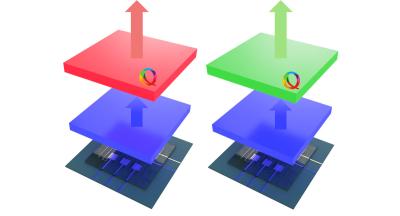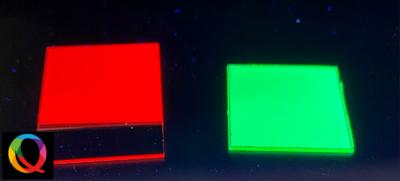We're happy to interview QustomDot, as part of our series of interviews with MicroLED Industry Association members. QustomDot is an early stage company that develops quantum dots materials tailored for microLED display applications.
Hello! Can you introduce your company and technology?
Kim De Nolf, QustomDot's co-founder and CEO: QustomDot is a technology startup that specializes in the development of customized quantum dots for down-conversion applications. Quantum dots are semiconductor nanocrystals that exhibit unique optical properties, making them useful in areas such as displays, solar cells, and biomedicine.
With our unique InP product line, QustomDot targets the QD-OLED and QD-microLED display markets where quantum dot color conversion solves many of the open technical challenges. Our in-depth expertise in QD synthesis, surface chemistry and ink formulation enables solutions that combine the challenging specifications for high-end displays, such as high blue light absorption in μm-sized films, efficient light conversion to red and green, and stable operation under high blue light flux. In our development tracks we keep a keen eye on processing technologies that are suitable for mass manufacturing.
Through close collaboration and rapid prototyping with customers, QustomDot enables radiant colors in its customers’ devices. Our goal is to enable high-quality and high-brightness microLED displays and to accelerate the commercialization of QD-enabled microLED applications such as smartwatches and AR glasses.
Can you say why you joined the microLED association and what it is you hope to achieve?
The required technology and manufacturing processes for microLED displays are very different from the current mature processes for LCD, OLED or LED manufacturing. Challenges exist at different levels and current technologies and ecosystems cannot provide satisfactory solutions for microLED. A concerted effort to stimulate collaboration, to bring together companies in the microLED space and to openly discuss challenges and solutions can therefore act as a catalyst in growing new microLED ecosystems. This is exactly what the microLED association does and this resonates with our vision of building sustainable ecosystems. Joining the microLED association enables us to create value together with like-minded companies and to bring microLED to a next level.
What is your biggest challenge, and success to date in the microLED industry?
There is still some misconception in the industry that InP-based materials are not suited for microLED down-conversion although we can show, and we have consistently shown over the years, that InP-based quantum dots can perform very well in microLED conditions. Our biggest success is that we keep providing our customers with solutions that keep harmful cadmium- based materials out of their products, despite the challenging specifications for microLED applications.
Can you detail your latest prototype/demonstration?
To date, our main prototypes are thin QD color conversion films where we demonstrate excellent optical properties in conditions that are relevant for a range of microLED applications. The image below shows red and green InP-based QD films where more than 90% of blue light is absorbed in a 5 μm thin film. Including its high color conversion efficiency, excellent color points, and robust photostability, our technology is moving quickly towards application targets. We are currently working on solutions to structure these formulations into subpixel micropatterns. You can expect some more exiting demonstrators from us in 2023, where we go from macro to micro.
How do you see microLEDs changing the display industry in the next 5-10 years?
Displays are omnipresent and are key interfaces between the real world and the growing digital world. Optical properties and manufacturing costs have improved tremendously over the years but today’s displays still come with several drawbacks. Currently, the display is the most significant contributor to the overall energy consumption of electronic devices. MicroLED, and especially blue microLEDs combined with red and green QD color conversion, can deliver displays with very high energy efficiency. First of all this has a positive impact on the consumption of a scarce resource, and at the same time it provides an extra degree of freedom allowing more creative display designs, since they will be less impacted by bulky battery pack requirements. Combined with flexible and transparent form factors, and with new technologies such as AR/VR, we believe that microLED will tremendously impact the types of display products that will be available to the consumer in the next 5-10 years.
Building cost effective microLED displays will require the development of new technologies and manufacturing processes. Apart from a range of new display products, this will potentially lead to a disruption of the existing supply chain. Although it is difficult to predict exactly how, it is quite reasonable to say this will lead to big changes in the display industry, and this represents interesting opportunities for smaller companies, emerging technologies and potentially even new manufacturing regions. It is an exciting time for the display industry, and we are looking forward to the unfolding changes. Despite the changes ahead, one thing is absolutely clear to us – in the quest for microLED products the role of quantum dots is yet to be fully leveraged.

